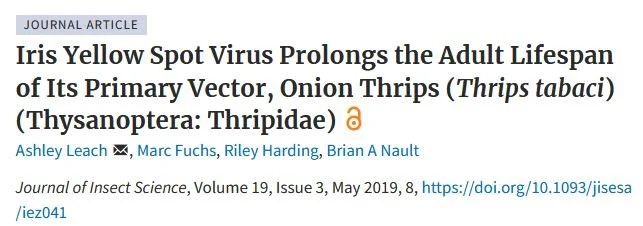Tosposviruses are weird. Ask any plant virologist. As a taxonomic group, they mostly impact animals (save for some protozoans). In agriculture, topsoviruses are a big problem for an array of agronomic crops. Annually, we can expect millions of dollars lost from these viruses. In onion production, we face challenges with iris yellow spot virus which causes Iris yellow spot disease. This pathogen is principally transmitted by onion thrips. While other tospovirus-thrips relationships have shown to result in both favorable and detrimental impacts to their vector (or should I say host?)….but we have limited knowledge on how onion thrips might benefit or suffer from an iris yellow spot infection.
This is my ‘no-duh’ graph since it shows that thrips that lived longer had more babies. But what’s important here is that we didn’t observe the vector status of the thrips impacting progeny (Phew!). Each data point represents a single mother and the total number of her progeny. No significant difference in progeny between these groups, but viruliferous thrips tended to live longer. (Relationship between an onion thrips mother’s lifespan and her total progeny (number offspring over lifespan) produced for mothers that were either viruliferous with iris yellow spot virus or were not viruliferous.)
Abstract
Iris yellow spot virus (IYSV) from the genus Tospovirus, family Peribunyaviridae, reduces yield in several crops, especially Allium spp. IYSV is primarily transmitted by onion thrips (Thrips tabaci), but little is known about how IYSV impacts the biology of its principal vector. In a controlled experiment, the effect of IYSV on the lifespan and fecundity of onion thrips was examined. Larvae were reared on IYSV-infected onions until pupation. Individual pupae were confined until adults eclosed, and the lifespan and total progeny produced per adult were monitored daily. Thrips were tested for the virus in reverse-transcriptase polymerase chain reaction using specific primers to confirm the presence of IYSV. Results indicated that 114 and 35 out of 149 eclosing adults tested positive (viruliferous) and negative (nonviruliferous) for IYSV, respectively. The viruliferous adults lived 1.1-6.1 d longer (average of 3.6 d) than nonviruliferous adults. Fecundity of viruliferous and nonviruliferous onion thrips was similar with 2.0 ± 0.1 and 2.3 ± 0.3 offspring produced per female per day, respectively. Fecundity for both viruliferous and nonviruliferous thrips also was significantly positively correlated with lifespan. These findings suggest that the longer lifespan of viruliferous onion thrips adults may allow this primary vector of IYSV to infect more plants, thereby exacerbating IYSV epidemics.

